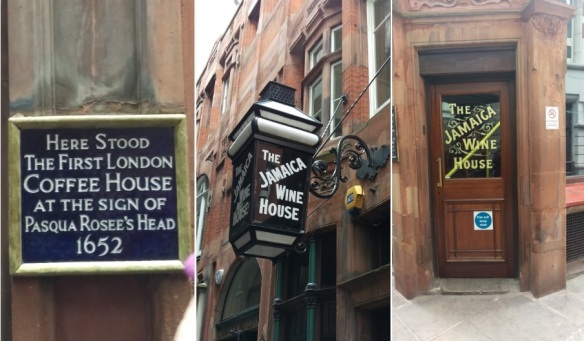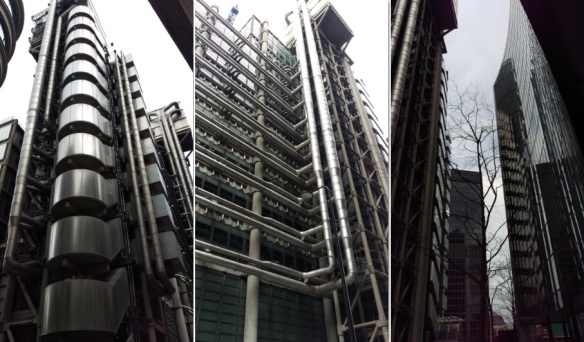It’s been over a month since my last historic meander so I am pleased to report that yesterday I spent a couple of hours weaving through the City’s streets in an effort to discover more about London’s connections with slavery.
We all know it happened and movies like 12 Years a Slave and The Butler have raised the public consciousness in recent years. But these have been portrayals of slavery in America and the Caribbean. When you look at these depictions and think about the inter-continental trading relationships that underpinned this industry…

Source: www.discoveringbristol.org.uk
…a picture of Britain is noticeably absent.
So yesterday I met with Museum of London guide Mike (yes he of my Roman fort tour earlier this year) and along with about twenty others, embarked on Sugar and Slavery, a two hour walking tour around the key British institutions involved the slave trade.
Here’s how it went.
From our meeting point at the museum, we walked down Noble Street, pausing opposite the Goldsmith’s Company for Mike’s introduction to the slave trade, before heading down Gresham Street to Guildhall Yard.

Entering Guildhall Yard from Gresham Street – the Yard is built on the site of the old Roman amphitheatre.
The guilds were organisations that represented the wide variety of trades – and as such controlled the various industries – operating in the City of London. In the 17th century, Guildhall was the central seat of justice for the guilds and many a legal battle was fought in Guildhall itself.

The Grade 1 listed Guildhall
Guildhall continues to be the administrative and ceremonial centre for the one square mile that constitutes the City of London. I remember watching Stephen Fry’s Key to the City a couple of years ago where he explored what it meant to have been awarded the ‘Freedom of the City’. He also attended a banquet here – it still seemed full of tightly-held traditions and much pomp and ceremony.
We headed out onto Lothbury Street, turned down Princes Street…

The Bank of England, taken from the corner of Lothbury Street and Princes Street
…to reach Bank Junction where we stopped outside the Royal Exchange. The Threadneedle Street entrance to the bank loomed above us on one side and Mansion House, the official residence of the Mayor of the City of London stood across the traffic circle in front of us.

Mansion House, official pad of the City’s Lord Mayor. No that’s not Boris Johnson – he’s the Mayor of Greater London which does not include the City. The current – and 688th – Lord Mayor of the City of London is Jeffrey Evans.

A pause outside the Royal Exchange
The Royal Exchange, founded by Thomas Gresham in 1565, operated much like today’s stock exchange – albeit without the technology – with traders and the city’s financial pundits going at it hammer and tongs from the opening to the closing bell. However, there was a point when it was suggested that business dealings should be negotiated outside the Exchange and so the emergence of coffee houses began.
You may be wondering what this all has to do with slavery – well, everything.
Slavery underpinned the British economy and pretty much allowed rich men to get even richer. Mike told us about one such man, David Lyle, an ‘absentee’ plantation owner who was also, by all accounts, a cruel master. It is recorded that Lyle pistol-whipped one of his slaves, Jonathan Strong and left him for dead on a London street. Strong was found by Granville Sharp – one of the first campaigners in Britain for the abolition of the slave trade – who nursed Strong and offered him work.
Legal battles ensued between Sharp and Lyle (once the latter learned that Strong was alive) with the Lord Mayor eventually pronouncing that Lyle had no claim as Strong was not ‘property’. This was the very same institution who legislated that slaves on ships could be thrown overboard – like possessions – should the captain believe his crew were in danger (eg. of starving due to provisions running out) and also supported the traders’ insurance claims to redeem losses from such activities.
But I digress.
The buying and selling of slaves moved out of the Royal Exchange (officially) and into coffee shops.

The Jamaica Wine House (nee Coffee House) stands on the site of London’s first coffee house.
The importation of raw materials such as coffee and sugar flourished with this rise of informal ‘trading houses’ and a young West African could have his or her horrific fate sealed over this bitter brew sweetened with sugar.
We paused on Lombard Street near the Church of St Mary Woolnoth to hear about John Newton who, after years of trading and torturing slaves, reformed and became rector here in 1780. He gets a mention from me because along with poet William Cowper, he composed a book of hymns in the 1770s – the most famous of these ‘Olney Hymns’ was Amazing Grace…and I cannot tell you how many times I played that as a child when I started learning each of the recorder, clarinet, flute and violin.
We headed on past the Monument (that’s the one to the Great Fire of London) and down to the riverside by Old Billingsgate, Mike continuing to paint a picture of the sickness and fear that these men, women and children who’d been torn from their loved ones, faced firstly on-board the slave ships then upon their arrival, where they’d be poked and prodded like animals before being sold, and finally in being ‘seasoned‘ on the plantations of Barbados and Jamaica.
Our next to last stop was Lloyd’s of London, a towering metal edifice of power and money.

The original Lloyd’s of London was a coffee house in Lombard Street and as well as playing host to the wheeling and dealing of London’s businessmen, became known as a place where one could obtain marine insurance – much like it is today. That the slave trade was conducted across the Atlantic suggests that Lloyd’s too has its roots steeped in the horrors of human trafficking.
Just down a nearby alley stands the Gilt of Cain, a memorial to the abolition of the slave trade in 1807 that was erected in 2008. It was a fitting way to end the tour.

I walked thoughtfully back to the tube station, comparing what I’d seen in movies with the stories of the people who perpetrated, fought and suffered that I’d just heard. There was so little humanity and dignity in each of the different stories that Mike had shared. Some of this I recalled as I walked but in essence, it felt like a fraction of the full story.
There’s a part of me that wants to learn more. While I’ve seen 12 Years a Slave – and found it viciously confronting – somehow each tale told over the two hours of the walking tour left more of a mark. I’m travelling to Liverpool next week, the largest of the old slave trading ports and home to the International Slavery Museum so it is a perfect opportunity.
But it also feels a bit raw – I feel appalled, my belief in the human spirit dented a little so while I will make the most of the educational opportunity that Liverpool will afford, it may be a little while before I venture into anything more.

Grim tales of man’s inhumanity to man and it still it goes on.
LikeLiked by 1 person
So true Jack
LikeLike